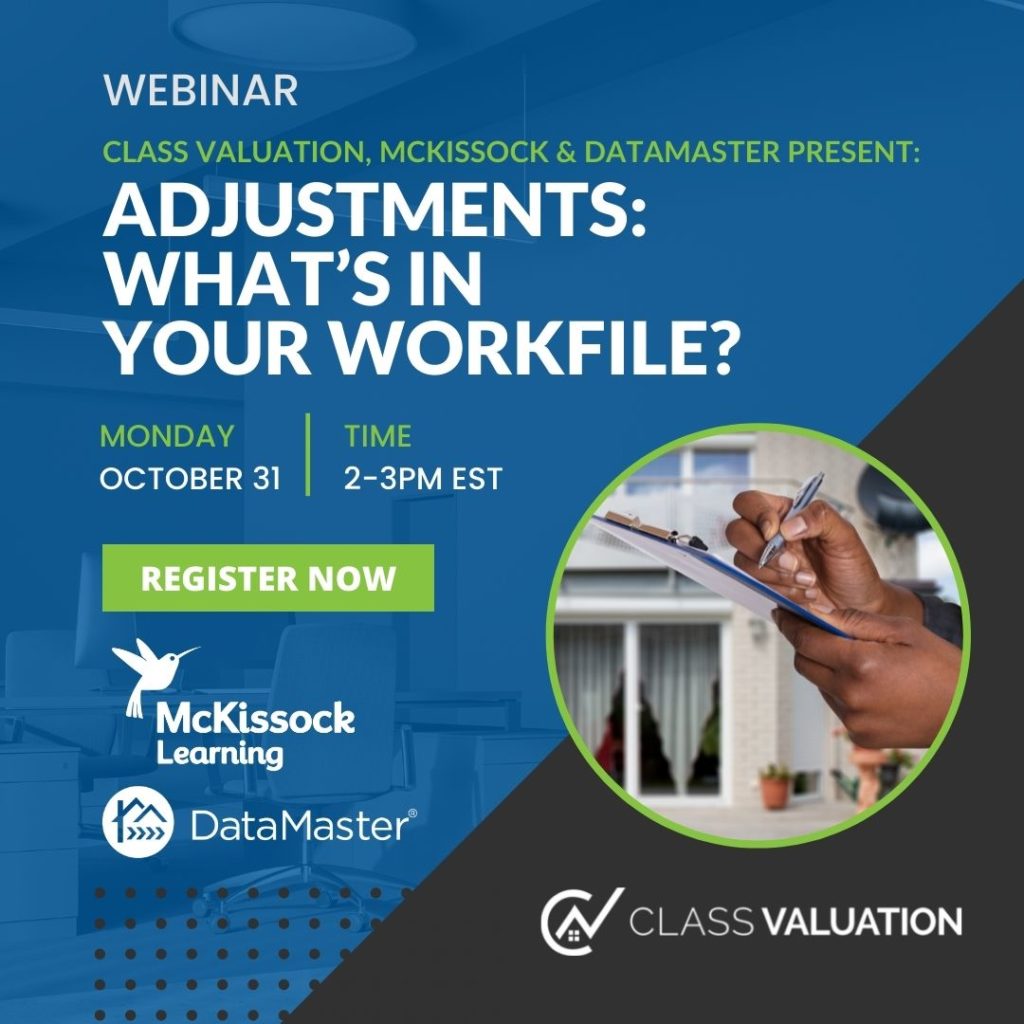Adjustments are approached in different ways by appraisers everywhere. Changing market data, trends, and consistent work files all impact adjustments – learn from the experts during our free webinar on October 31st at 2 pm, “Adjustments: What’s in Your Workfile?” with Mel Black of McKissock, John Dingeman, Chief Appraiser of Class Valuation, and Danny Wiley, Senior Director of Single-Family Valuation at Freddie Mac. We sat down with our hosts to dive into what they’ll be covering during the free webinar.
Buzz: What are your backgrounds within the appraisal industry?
Mel Black: I’ve been in the profession in some capacity for 30 years. I am the Director of Appraisal Innovation at McKissock Learning. I was first licensed as an appraiser in 1991 and as a real estate broker in 1988. I am an AQB-Certified USPAP Instructor and an attorney in private practice with a focus on representing real estate appraisers and other professionals before their licensing boards.
Danny Wiley: I am the Senior Director of Property Valuation for Freddie Mac’s Single-Family Risk Management division. I have held appraisal-related positions since 1982, including over 25 years as an independent fee appraiser and eight years as an AMC chief appraiser. At Freddie Mac, I am responsible for its collateral risk management and its valuation team. I’m also responsible for innovation in collateral risk analysis.
John Dingeman: I am a Certified Residential Appraiser and Registered Property Tax Agent. I am also a Continuing Education Instructor for appraisers, assessors, sales agents, and loan originators. I am the Chief Appraiser for Class Valuation, one of the largest non-lender-owned Appraisal Management Companies (AMCs) in the country, and have served in this role for the past 9 years for several AMCs.
Buzz: What trends can we expect to see covered by Freddie Mac? What data do you see that feeds into the challenges with adjustments?
Danny Wiley: The trend we’re seeing most recently is that markets are changing, and in some cases, they are changing rapidly. It is critical that appraisers are conducting appropriate market analysis and not relying on stale data when reporting market conditions and/or market conditions adjustments.
Buzz: The market data today is changing a lot faster than we’ve seen it in many years – thoughts on best practices on how to derive adjustments based on market data during today’s market?
John Dingeman: The market is cyclical. Over the past decade, appraisers have been reluctant to apply market conditions adjustments to sales in an increasing market. After the market collapse in 2008, I understand why. It is important to recognize that a zero-dollar adjustment is an adjustment and any adjustment must be supported. The application of supported adjustments, those that reflect market behavior, only strengthens the opinion of value. After more than a decade of growth and unprecedented appreciation in real estate values, we faced a global pandemic in 2020 which impacted consumer behavior and the real estate market in several ways. The opportunity to work remotely and live anywhere while doing it increased activity and demand and reduced the inventory to record lows.
Buzz: From a GSE perspective, what specific data do you expect the appraiser to include in a report and work file to support all of these adjustments?
Danny Wiley: Freddie Mac policies specifically call out that the use of unsupported adjustments is unacceptable appraisal practice. To that end, it is expected that all adjustments (even adjustments of $0) are credibly supported in the workfile and explained within the appraisal report.
Buzz: You’re reviewing files, adjustments, reconsideration requests, etc. all the time at Class – What are the common do’s and don’ts?
John Dingeman: Technology is our friend and far too many appraisers have referenced digital data in their workfile with the assumption that it would always be available. For a variety of reasons, data is being swiped clean from the internet. That reference simply points to a “404 URL Not Found” page. Digital storage today is readily available and inexpensive. Our technology providers, like DataMaster, can even store our entire workfile for us which can include the entire MLS listing and all of the photographs for both the subject property and the comparables. Leveraging technology and ensuring that we maintain a workfile that would allow the appraiser (or an appraiser) to recreate the appraisal is paramount.
Buzz: Why should appraisers join this webinar?
Mel Black: This webinar is to help appraisers derive adjustments based on market data, to remind appraisers what is needed in their reports and workfiles to support their adjustments, and to bust common myths and memorized shortcuts that are not accepted appraisal mythology. We will provide statistics and background on trends that Freddie Mac may be seeing, and we will be responding to reasonable on-topic questions from the audience.
Thank you all for answering these questions and make sure to join our free webinar on October 31st at 2 pm, “Adjustments: What’s in Your Workfile?”








